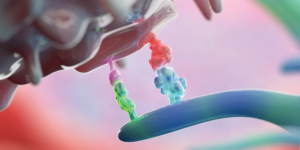
3D rendering of immune checkpoint molecules on a T cell and a dendritic cell.
Alpha Tauri 3D Graphics / shutterstock.com
Immune checkpoint inhibitors (ICIs), such as anti-programmed cell-death 1/programmed death-ligand 1 (anti-PD-1/PD-L1) or anti-CTL-associated protein (anti-CTLA-4), have dramatically changed the treatment of advanced cancers over the past decade. ICIs block T cell inhibition, thus increasing the anti-tumor immune response. ICIs are used not only for metastatic cancer, but also as adjuvant treatment for some stage 3 cancers, and they are most effective for tumors with a high mutational burden.
However, these agents often cause immune-related adverse events (irAEs). Of all such adverse events, 6–7% are rheumatic in nature.1 Given the growing use of ICIs, particularly for common malignancies, such as non-small cell lung cancer, most rheumatologists will evaluate and manage such patients in routine clinical practice. This field is in its infancy, so the evidence guiding treatment decisions is sparse. What follows are some typical case scenarios and our answers to questions that often arise.
Case 1
A 71-year-old man with metastatic non-small cell lung cancer treated with three months’ of nivolumab (an anti-PD-1) develops joint pain, swelling and stiffness, most severe in the right knee. Knee arthrocentesis is consistent with an inflammatory arthritis. After one month of relief from an intra-articular steroid injection, he presents to you with bilateral, symmetrical arthritis in his metacarpophalangeal and proximal interphalangeal joints, wrists, shoulders and knees. How should you treat him?
ICI-arthritis
This patient has developed an inflammatory arthritis, ICI-arthritis, precipitated by anti-PD-1 treatment. ICI-arthritis occurs in 4% of patients treated with an ICI.2 The median time to onset is four months; however, it can occur days after the first infusion of ICI or even months after ICI treatment has been discontinued.3
Patients with ICI-arthritis may present with mono- or oligoarthritis, often involving the knees; a rheumatoid arthritis-like, polyarticular pattern that may overlap with polymyalgia rheumatica; or more rarely, a spondyloarthritis pattern (see Table 1,4).
Over time, a lower extremity oligoarthritis may evolve to a symmetrical, polyarticular pattern. Less common presentations, including a tenosynovitis-only pattern and osteoarthritis exacerbations, have been described.
Evaluation of these patients should include bloodwork, arthrocentesis, if possible, and imaging. Other causes of inflammatory arthritis, such as infection, crystal disease or reactive arthritis, should be ruled out. Rheumatoid factor and anti-cyclic citrullinated peptide antibody are positive in about 10% of patients, but it is unknown whether this reflects post-ICI treatment seroconversion or persistence of pre-treatment seropositivity.3
Although ICI-arthritis is often too acute for erosive disease to be noted on X-ray imaging, erosions have been demonstrated by ultrasound in some patients, and proliferative pannus formation and bone erosions can also be seen pathologically (see Figures 1A–C, opposite).5 Review of patients’ surveillance positron emission tomography (PET) scans can help identify bone metastases, if they are present, and magnetic resonance imaging (MRI) can also be used for patients with atypical presentations.
irAEs are assigned a grade as determined by the Common Terminology for Cancer Adverse Effects (CTCAE) criteria.6 Grades 1 and 2 are defined as mild and moderate pain, respectively, and inflammation that does not interfere with activities of daily living (ADLs); to achieve grade 3, severe pain must interfere with ADLs.
ICI-myositis tends to occur within two months of ICI initiation, although it can occur later as well. As with other irAEs, the most severe cases most frequently occur soon after treatment with the ICI begins.
CTCAE grading does a poor job of distinguishing the severity of arthritis activity. Thus, clinicians may find it useful to monitor response to therapy using rheumatoid arthritis disease activity measures, such as the Clinical Disease Activity Index (CDAI), the Disease Activity Score for 28 Joints (DAS28) and the Routine Assessment of Patient Index Data 3 (RAPID3).
Treatment Approaches



